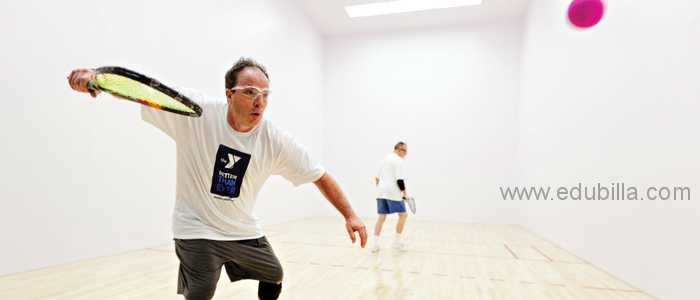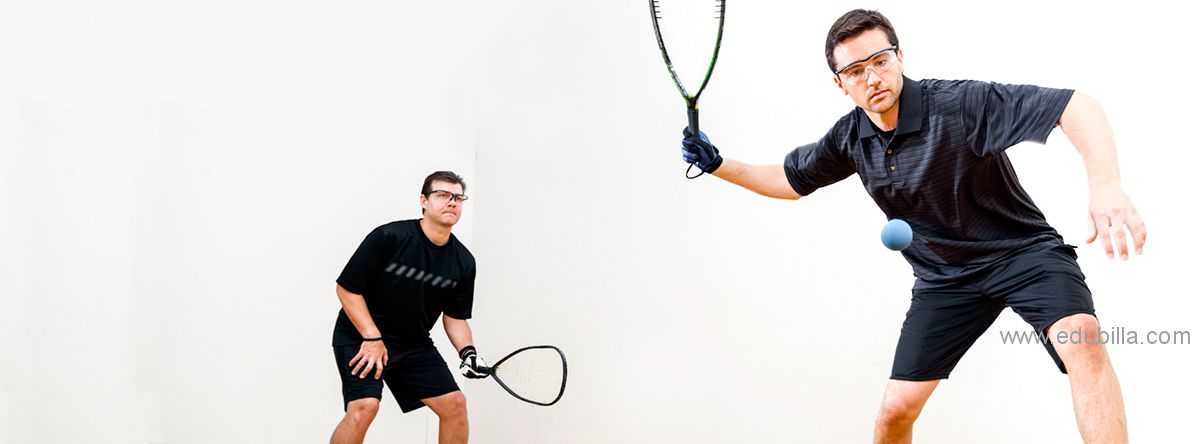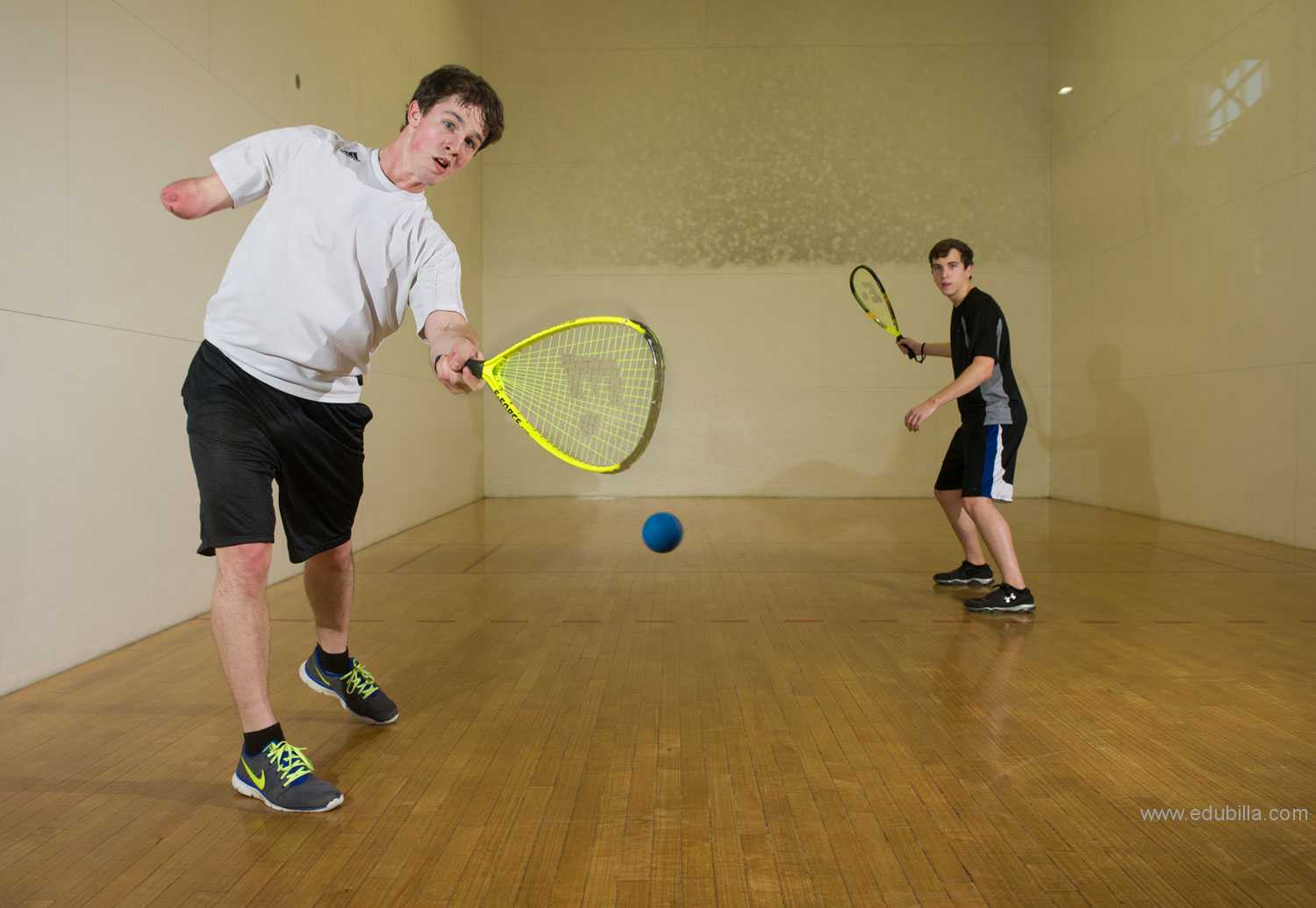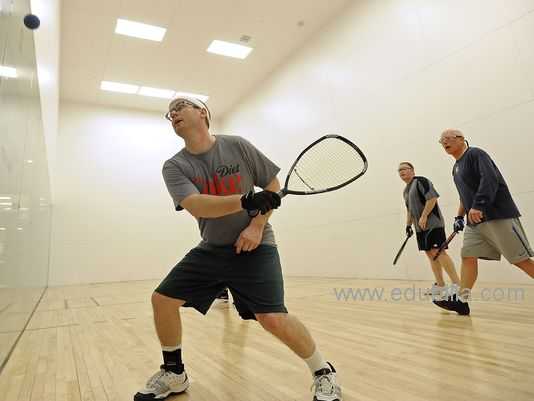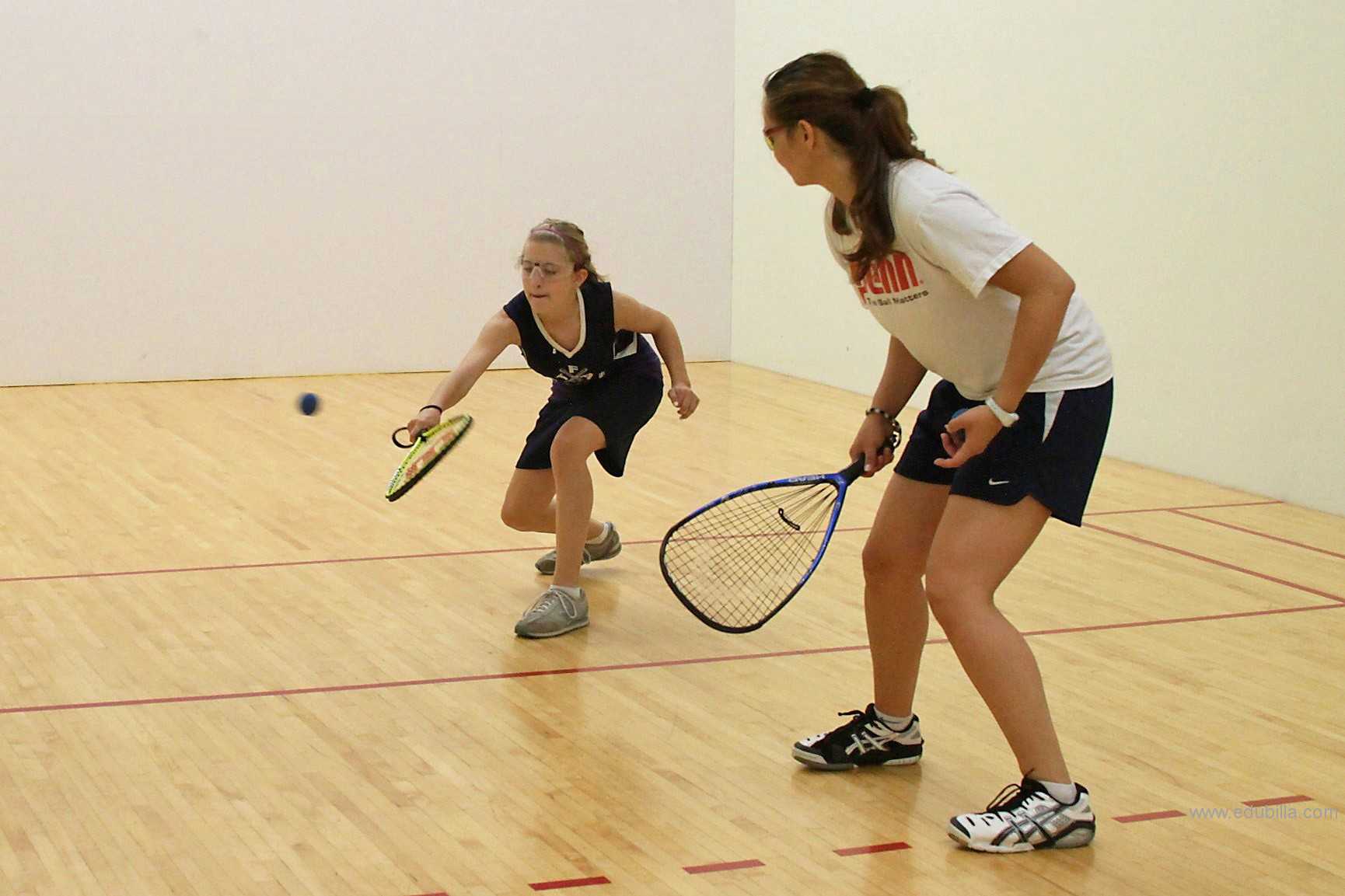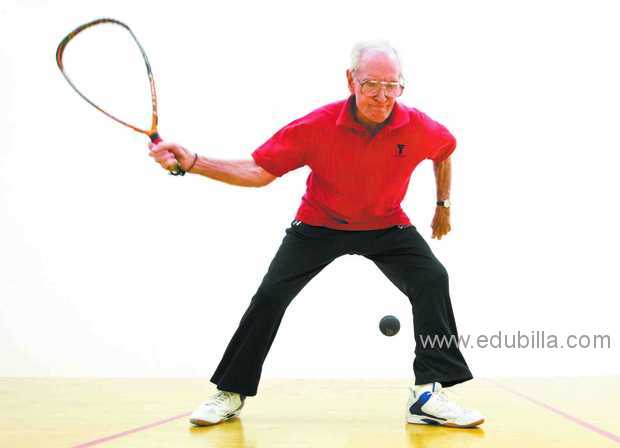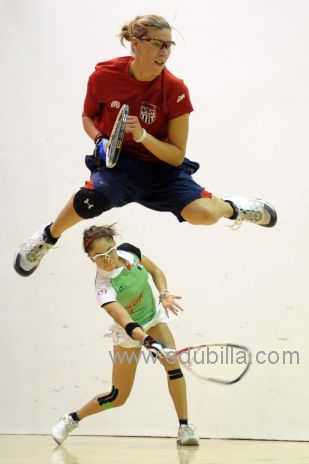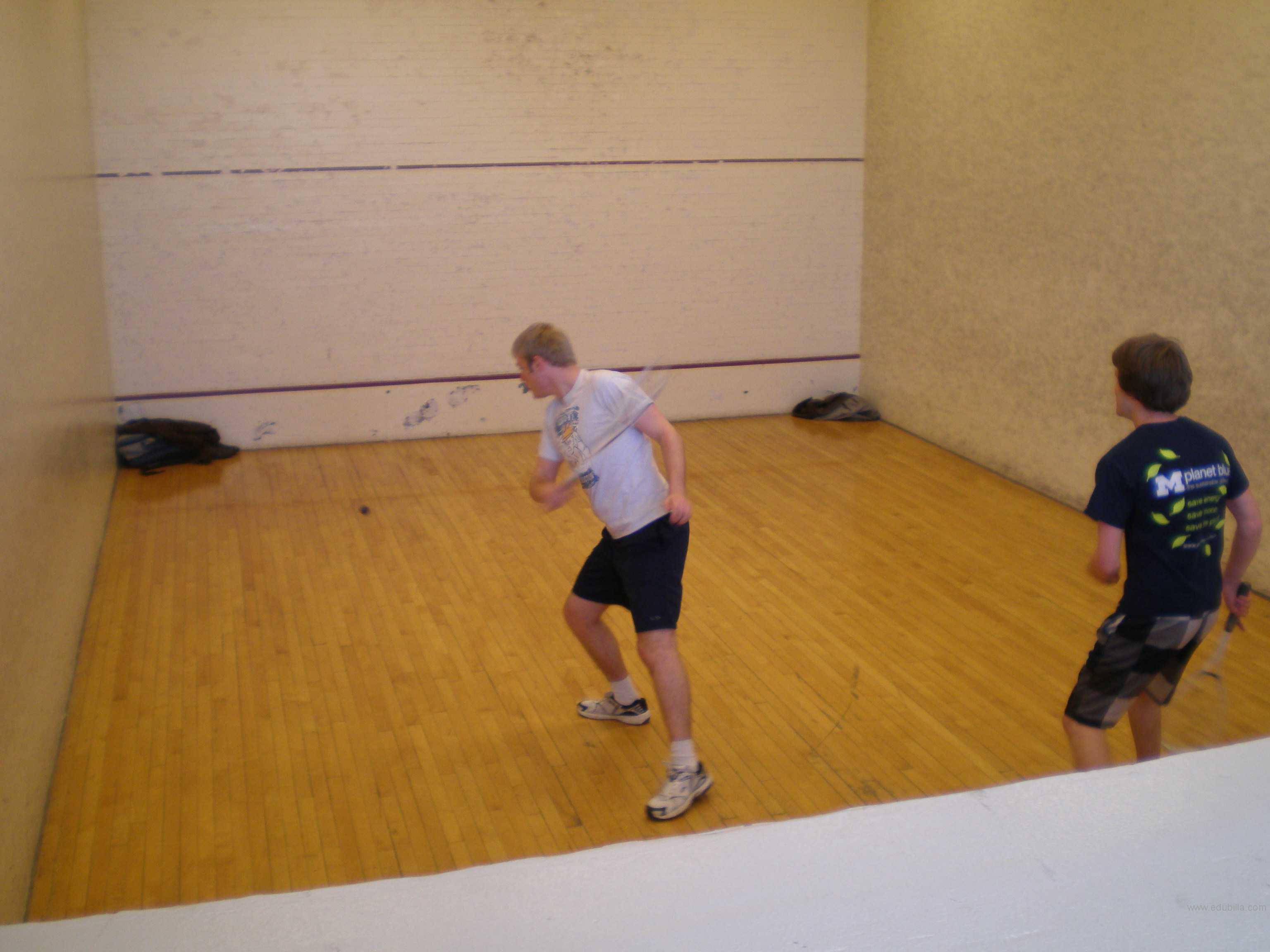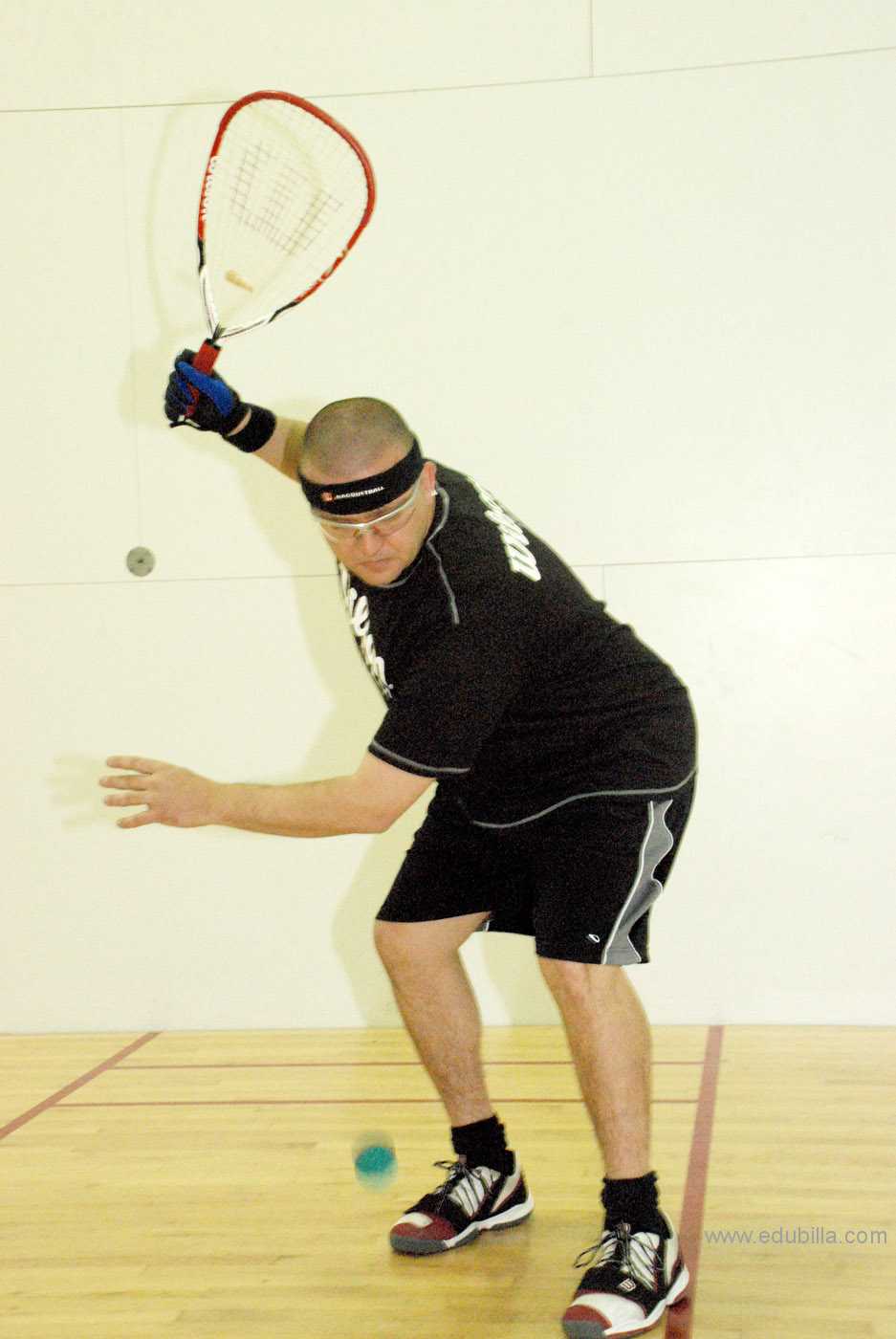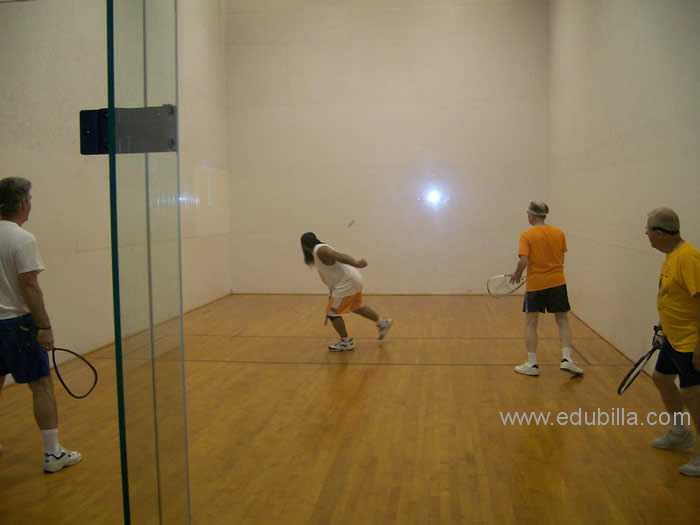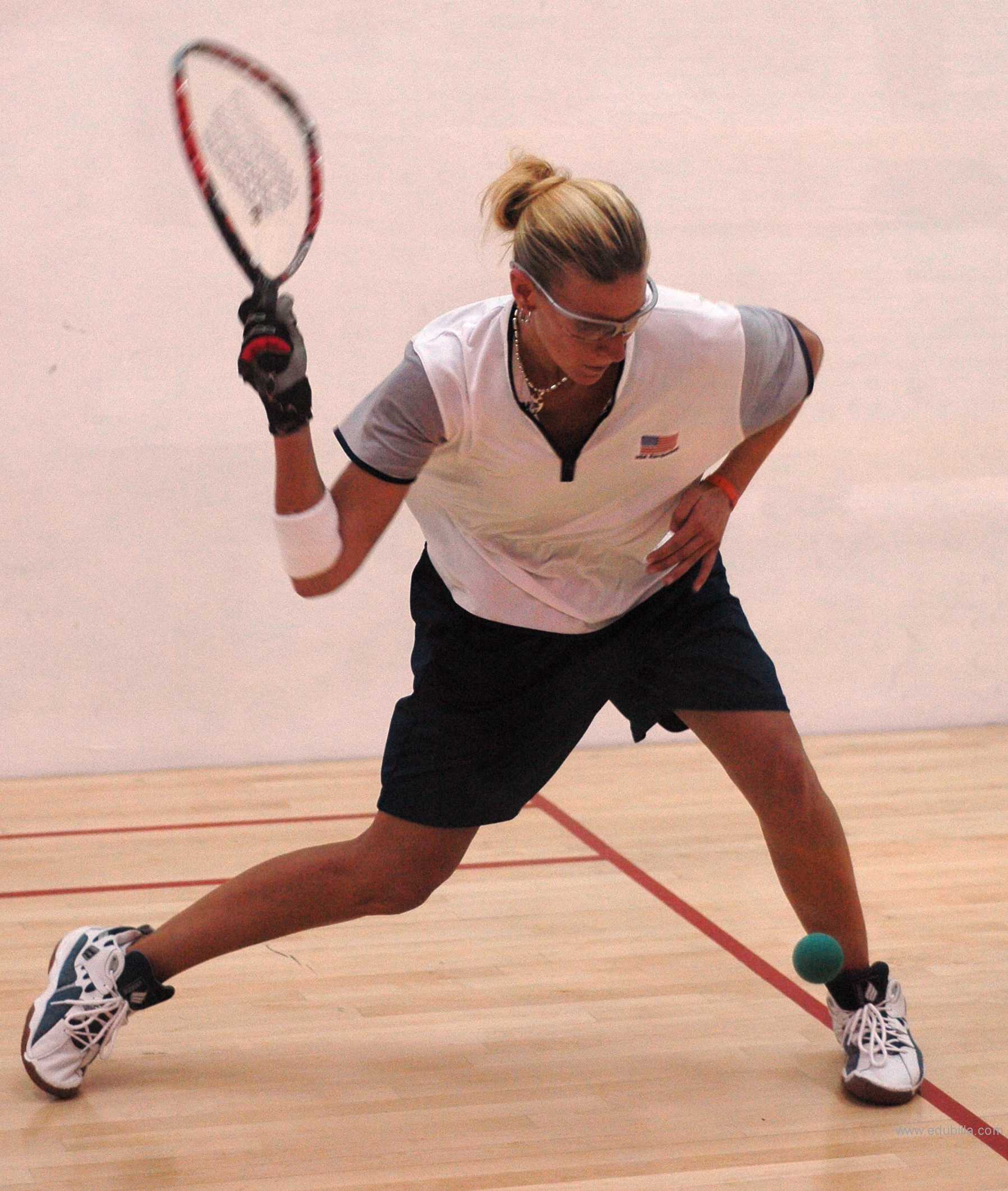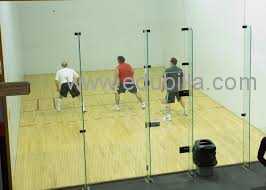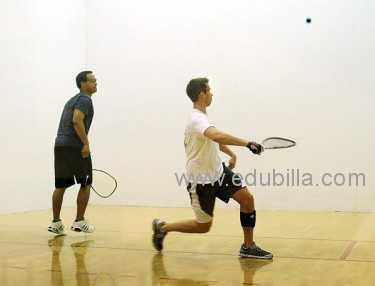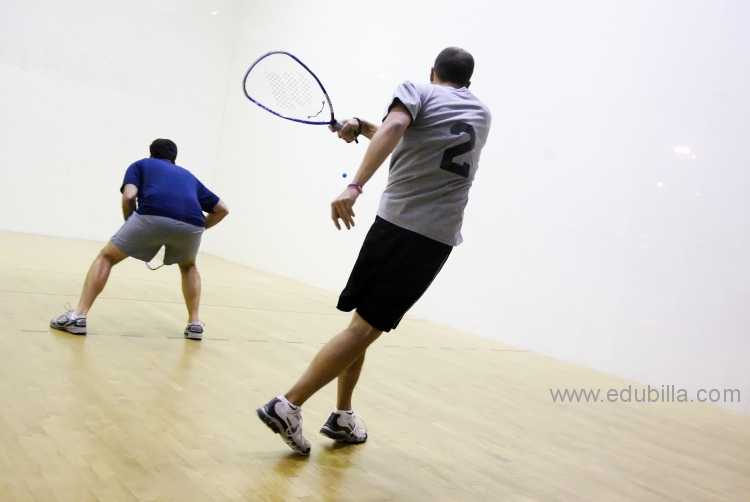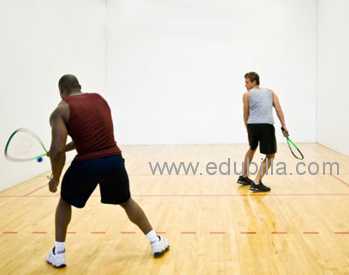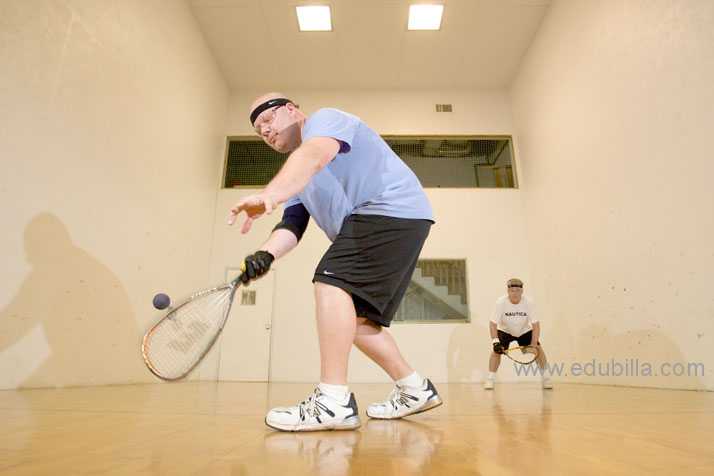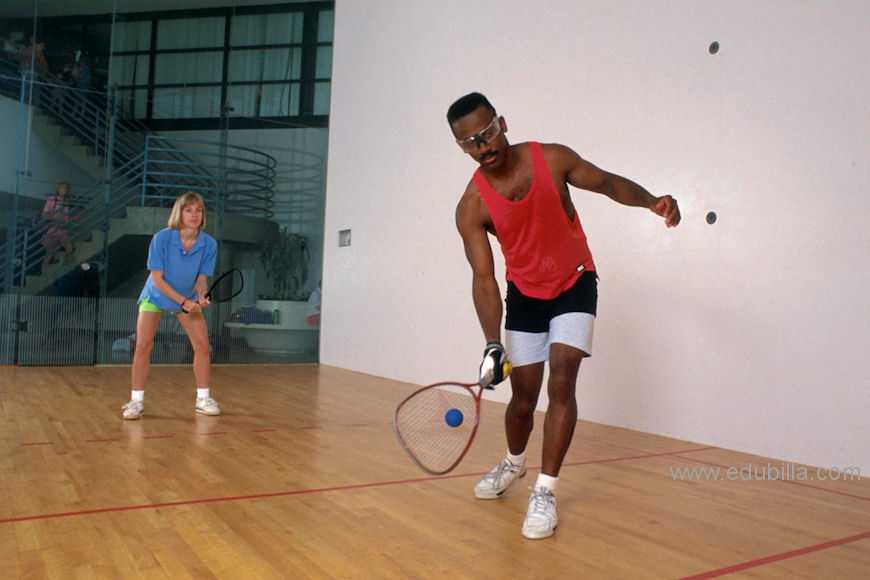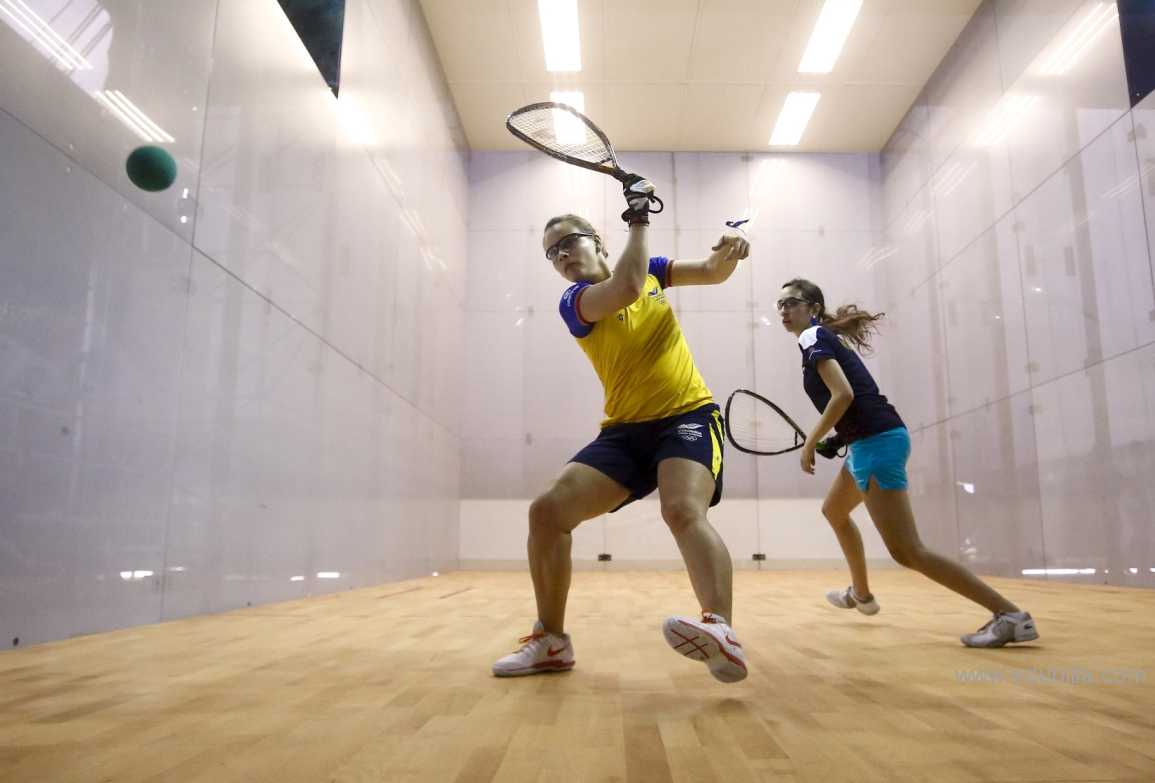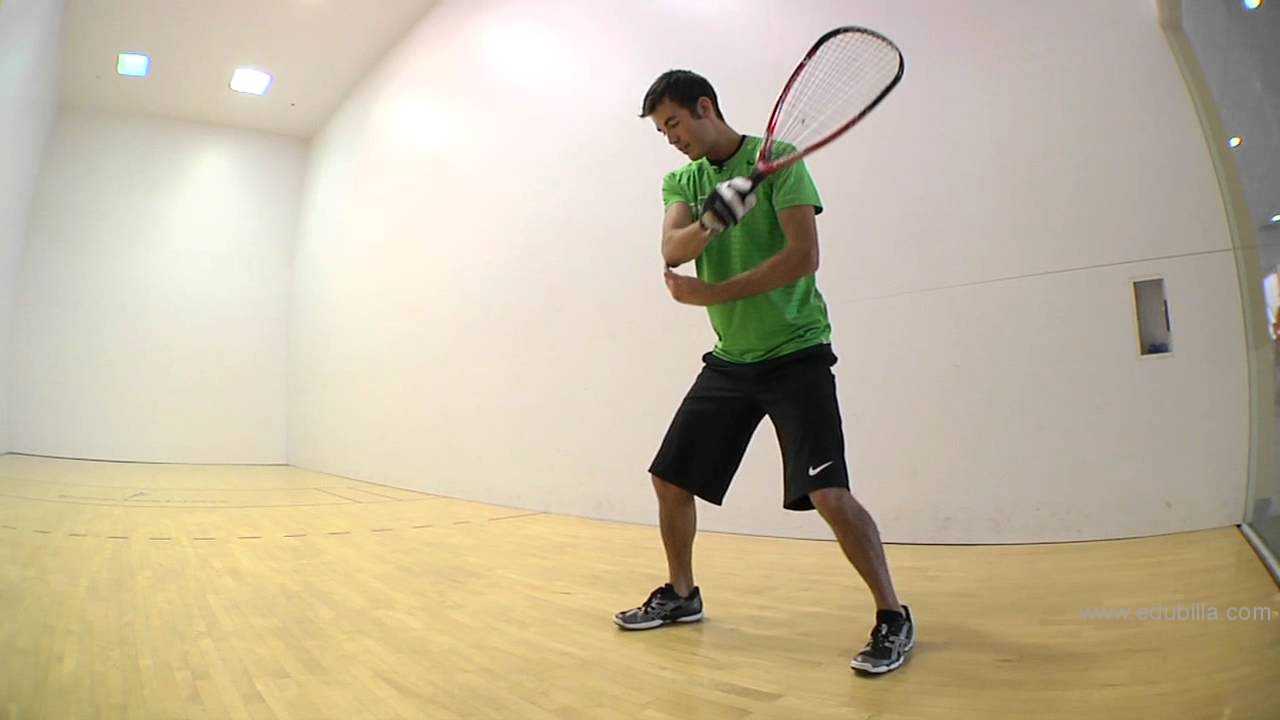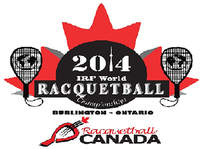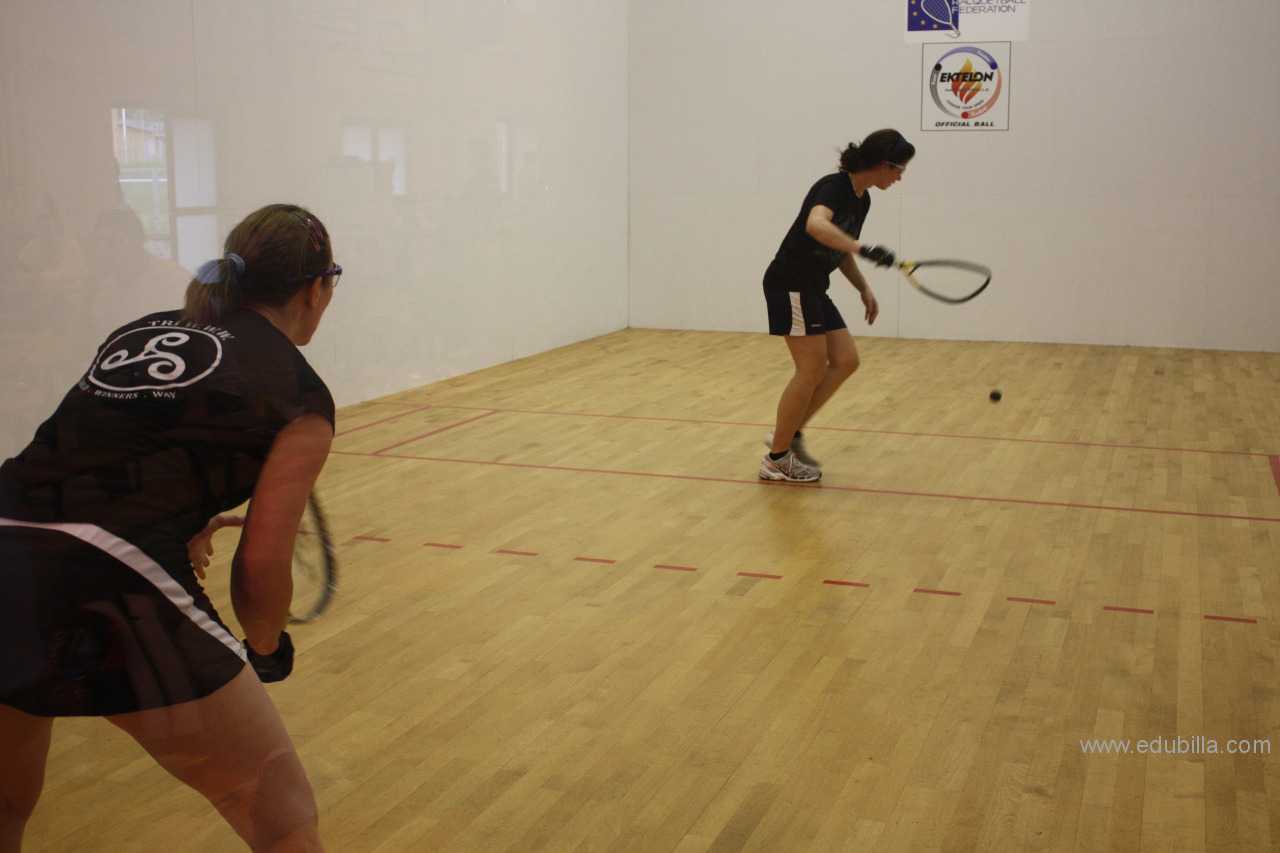
Overview Of Racquetball
Racquetball is a racquet sport played with a hollow rubber ball in an indoor or outdoor court. Joseph Sobek is credited with inventing the modern sport of racquetball in 1950,adding a stringed racquet to paddleball in order to increase velocity and control. Unlike most racquet sports, such as tennis and badminton, there is no net to hit the ball over, and, unlike squash, no tin (out of bounds area at the bottom of front wall) to hit the ball above. Also, the court's walls, floor, and ceiling are legal playing surfaces, with the exception of court-specific designated hinders being out-of-bounds.
Racquetball is very similar to 40×20 American handball, which is played in many countries. It is also very similar to the British sport racketball (see below for a comparison).
New Britain Connecticut YMCA:
Joe Sobek is credited with inventing the sport of racquetball in the New Britain Connecticut YMCA, though not with naming it. A professional tennis and American handball player, Sobek sought a fast-paced sport that was easy to learn and play. He designed the first strung paddle, devised a set of rules, based on those of squash, handball, and paddleball, and named his game paddle rackets.
National Paddle Rackets Association (NPRA):
In February 1952 Sobek founded the National Paddle Rackets Association (NPRA), codified the rules, and had them printed as a booklet. The new sport was rapidly adopted and became popular through Sobek's continual promotion of it; he was aided by the existence of some 40,000 handball courts in the country's YMCAs and Jewish Community Centers, wherein racquetball could be played.
International Racquetball Association (IRA) :
In 1969, aided by Robert W. Kendler, the president-founder of the U.S. Handball Association (USHA), the International Racquetball Association (IRA) was founded using the name coined by Bob McInerney,a professional tennis player. That same year, the IRA assumed the national championship from the NPRA. In 1973, after a dispute with the IRA board of directors, Kendler formed two other racquetball organizations, yet the IRA remains the sport's dominant organization, recognized by the United States Olympic Committee as the American national racquetball governing body.
In 1974, the IRA organized the first professional tournament, and is a founding member of the International Racquetball Federation (IRF). Eventually, the IRA became the American Amateur Racquetball Association (AARA); in late 1995, it renamed itself as the United States Racquetball Association (USRA). In 2003, the USRA again renamed itself to USA Racquetball (USAR), to mirror other Olympic sports associations, even if Racquetball is not an Olympic sport.
Game Rules
The Basic Rules of Racquetball:
Racquetball can be played three ways. Versions include "Singles Play" between two players, "Doubles Play" between two teams of two players each, and "Cut Throat," which involves three players. Tournament play usually involves either Singles or Doubles play. Regardless of the type of play, there are basic "Rules of the Game" that apply.
The Serve:
Play begins with the server standing in the Service Zone and serving the ball to his/her opponent(s). To serve, the server must first bounce the ball and then strike it with the racquet. The ball is put into play after making contact with the Play Wall first and then passing into the rear half of the court. In it's flight, the ball may strike one side wall, but no more. If it hits three surfaces including the ceiling or back wall before bouncing, the serve is not good (called one fault) and the ball is not in play.
Also, a serve that does not carry beyond the Short Line of the Service Zone is also not good (fault). Additionally, the ball cannot hit a side wall, floor or ceiling before the Play Wall when attempting to serve. The server is given two opportunities to put the ball into play. If the server hits two faults in a row, the player returning serve takes over in the service zone and the original server assumes the return of a serve position.
The Return of Serve:
To return serve, stand in the middle of the court (equal distance between each side wall) approximately one arm and racquets length away from the backwall. Return serve by striking the ball before the second bounce. The ball must travel to the Play Wall for it to be a good return of serve. The ball may hit ANY surface except the floor on the return as long as it hits the Play Wall before bouncing.
The Rally:
Once the ball is in play, each player alternates hitting the ball until one misses the ball or hits an illegal shot. Players try to earn points or win the serve by putting an end to a rally. Often this is done when a player's shot hits the front wall at its lowest point, causing the ball to roll out, rather than bounce back into the playing area (called a killshot or rollout). Points are also earned when rallies end with an error, or a "Skip Ball," i.e. when the ball makes contact with the floor before reaching the Play Wall.
Once the ball is in play, the walls and ceiling can be used for shot variations. Points are scored when after serving the ball, the server wins the rally. If the player returning serve wins the rally, the result is a sideout, no points are scored for either player and the player who won the rally gets to serve. Whoever wins the rally always serves next. Matches are typically two games to 15 points and a tiebreaker to 11 if needed.
Hinders:
Hinders are stoppages of play, and result in the replay of the point. It is your responsibility to give your opponent enough room to hit the shot the way they want to hit. You must hive them a straight shot to the front wall as well as the angle, which would result in a crosscourt shot to the opposite back corner. Typical hinders are:
A ball striking any part of the court, which results in an erratic rebound (fan vents, door knob, lights, etc.)
Accidentally hitting opponent with the ball as it is heading toward the front wall
Unintentionally contacting opponent while attempting to make a play on the ball
Screening opponent's view of the ball or having the ball pass between one's legs.
Basics to remember once you have started playing a game are:
1. Only the server scores points
2. The ball can only bounce once
3. The ball must return to the front wall after being hit
The Rules of the Racquetball Court:
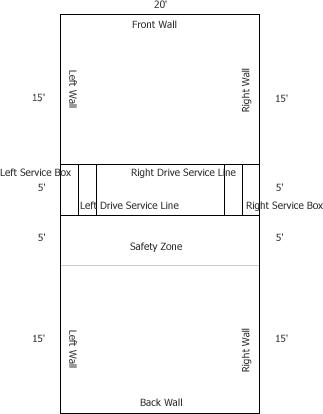
Front Wall
- All shots must hit this wall before hitting the ground to keep the ball in play.
- During the serve, the ball must hit the front wall first. Failure to do so results in a side out.
- A shot hitting the crotch (area were the front wall meets the floor) results in side out or a point.
Service Boxes
- The service boxes, used in doubles play, are located at each end of the service zone and are designated by lines parallel with the side walls and 18 inches from the nearest side wall.
- On each serve, the server's partner shall stand erect with back to the side wall and with both feet on the floor within the service box from the moment the server begins the service motion until the served ball passes the short line.
- If the server's partner enters the safety zone before the ball passes the short line, the server loses service.
- Any violations are called foot faults.
Drive Serve Lines
- The drive serve lines, which form the drive serve zone, are parallel with the side wall and are within the service zone.
- The drive serve lines are generally red or blue in color and unbroken.
- The drive serve lines are 3 feet from each side wall in the service zone.
- Viewed one at a time, the drive serve line divides the service area into a 3-foot and a 17-foot section that apply only to drive serves. The player may drive serve between the body and the side wall nearest to where the service motion began only if the player starts and remains outside of the 3-foot drive service zone.
- In the event that the service motion begins in one 3-foot drive service zone and continues into the other 3-foot drive serve zone, the player may not hit a drive serve at all.
- However, the drive serve zones are not observed for cross-court drive serves, the hard-Z, soft-Z, lob or half-lob serves.
- The racquet may not break the plane of the 17-foot zone while making contact with the ball.
- The drive serve line is not part of the 17-foot zone. Dropping the ball on the line or standing on the line while serving to the same side is an infraction.
Left Wall and Right Wall
- If the ball hits a side wall before it hits the front wall on a serve only, then it is a sideout.
- In all other cases, the side wall is considered in play as long as the ball hits the front wall before it touches the ground.
Back Wall
- During a serve, the ball must hit the floor before it touches the back wall. If the ball touches the back wall first, then the serve is considered a fault.
- The ball can be hit after having hit the back wall, either towards the front or back at the back wall having the intention to eventually hit the front wall.
- A shot hitting the crotch (area were the back wall meets the floor) is legal for both serves and regular play.
Detailed Racquetball Rules Can Be Downloaded From Documents
Equipments Need For Racquetball
This court and equipment are required for playing racquetball:
Racquetball Court:
A racquetball court; fully enclosed indoor or outdoor with a front wall. The standard racquetball court is rectangular: 40 feet long, 20 feet wide, and 20 feet high with red lines defining the service and serve reception areas.
The "service box" is formed by the short line (a solid red line running the court's width parallel to the front and back walls at a distance of 20 feet) and the service line (which runs parallel to the short line and is 15 feet from the front wall). Within the service box there are two sets of lines perpendicular to the short and service lines.
One set of lines is 18 inches from, and parallel to, the side walls. Along with the short line, service line, and side wall these lines define the doubles box, where the non-serving doubles partner stands during the serve; 36 inches from the side wall is another set of lines which, along with the short line and the service line, define an area that the server must not enter if he wishes to hit a drive serve between himself and the nearest side wall. The receiving line is a parallel dashed line 5 feet behind the short line
Other equipment needed:
A racquetball: a dynamic (bouncy) rubber ball of 2.25 in. (57 mm) diameter
A racquetball racquet; no longer than 22 inches
Racquetball eyeguards (mandatory during competitions; some recreational players play without eyeguards but this is not recommended, as being hit in the eye by the ball can cause permanent vision damage)
Ball Colors:
Racquetballs are manufactured in a variety of colors such as blue, green, purple, black, red, and pink, and some are for specific purposes (e.g., outdoor play and indoor play), but the differences are unlikely to make much difference for recreational play. Beginners are recommended to use a blue ball by Penn, Ektelon, or Wilson. The blue ball is the most commonly used and it is the most neutral ball for average speed and accuracy of contact. Green balls are similar to blue balls. In the USA the main choices of ball are blue and green for tournament play. In some cases the International Pro Racquetball Tour (IRT) will use a purple Penn HD ball as the official ball. A black ball is often used in tournaments for senior players because the ball is designed to be slower moving and allows for longer rallies. The red ball is the fastest in production and they are known as Red Ektelon Fireballs. This ball is heavier and allows for a quicker pace.
Balls do break occasionally, and will lose their bounce over time even without breaking. To keep balls around for a long time it is best to keep them in a room temperature setting and keep them out of extreme cold or heat because this will cause the balls to become less effective and lose their bounce.
History Of Racquetball
Joseph G. Sobek (1918 – 1998) was the inventor of racquetball, although he is not credited with coining the name (he called it “paddle rackets”). He developed the sport while working in a rubber manufacturing plant in Bridgeport, CT. A resident of Greenwich, CT, Sobek was also a tennis pro and squash and handball player.
Historical Timeline
Joseph Sobek1949: Joseph Sobek, professional tennis and handball player, created a set of rules based on those of squash and handball and called it “paddle rackets.”
1950: Sobek, using the tennis racket as a pattern, developed plans for a new, short strung racket.
1952: Sobek founded the National Paddle Rackets Association. He codified a set of rules and printed them into booklets and sent them out to continue the promotion of his new sport.
1968: Sobek connected with Robert Kendler, head of U.S. Handball Association. Kendler was very interested in the new sport.
1968: Sobek held The First Gut-Strung Paddle Rackets National Championship in Milwaukee, Wisconsin.
Robert Kendler1969: Robert Kendler founded the International Racquetball Association. New paddle racket regulations were being discussed.
1969: The sport officially had its new name, Racquetball, coined by San Diego tennis pro, Bob McInerny.
1969: The first IRA National Singles was held in St. Louis, Missouri.
1969: Dayton Glove and Racquet introduced the first metal racquet.
1970: Bud Held, with Ektelon, introduced his first metal racquet, “Bud Muehleisen.”
1971: Aluminum alloy frames were introduced. The total racquet dimensions (length and width) averaged about 26 inches.
1972: The first pro tour was formed.
1972: The National Singles was held in Memphis, Tennessee.
1973: After a dispute with the board of directors, Kendler parted ways with the IRA and formed the National Racquetball Club.
1974: IRA held first pro tournament.
1974: A new membership requirement was established for all sanctioned tournaments. IRA membership was $3.00 per year.
1974: The number of amateur players in the United States jumped to an estimated 3 million.
1976: Kendler also founded the U.S. Racquetball Association (USRA) as a rival amateur organization that only lasted until 1982.
1976: Seamco 444 becomes the official racquetball ball of the IRA.
1979: The IRA changed its name to American Amateur Racquetball Association (AARA).
1979: The International Amateur Racquetball Federation (now just called the International Racquetball Federation) was formed, and it included 14 countries.
1979: Graphite frames were introduced.
1980: The men’s pro tour was established along with the Women’s Professional Racquetball Association (WPRA).
1981: The World Games I and The First Racquetball World Championships were held in Santa Clara, California. The United States wins first World Cup over 6 other countries.
1981: Penn introduces the “Ultra Blue” racquetball ball.
1982: AARA was accepted as member of the U.S. Olympic Committee.
1982: AARA signs racquet sponsorship with Diversified Products.
1984: Ektelon introduces and test markets the oversized racquet.
1984: Match rules changed from 21 points to 15 points per game, with 11 point tiebreaker.
1985: The International Olympic Committee recognized the sport of racquetball.
1986: A new mandatory eye guard rule is passed.
1986: The United States and Canada tie to share the World Cup in Orlando, Florida where 20 countries competed.
1986: The Pan American Racquetball Confederation (PARC) was formed.
1987: The First AARA National Leadership Conference held at the U.S. Olympic Training Center.
1988: The United States National Team wins World Cup over 22 countries.
1988: AARA televises its National Championships for the first time ever.
1989: Racquetball was granted full member status within the U.S. Olympic Committee.
1989: As the 38th sport, racquetball makes its premiere U.S. Olympic Festival appearance in Oklahoma City.
1990: The United States wins 5th World Cup in Caracas, Venezuela over 28 countries.
1991: AARA telecasts ten national events on cable channels.
1991: The Unites States Team Alumni Association is formed.
1991: Racquetball was placed on the schedule for the Pan American Games in 1995.
1993: AARA celebrates 25th Silver Anniversary.
1994: The United States wins 7th World Cup in San Luis Potosi over 27 countries.
1994: IRF adopts “one serve” rules in international competition.
1995: Racquetball makes its debut in the Pan American Games in Buenos Aires, Argentina, and the United States National Team sweeps medal count.
1996: U.S. Open Racquetball Championships debut in Memphis with pros and amateurs in a single event, played on a specially-constructed “made for TV” glass court.
1996: The United States wins 8th World Cup team title.
1997: The IRA changes its name again to United States Racquetball Association (USRA).
1997: USRA changes rule to allow oversized frames of 22” in length. Total length and width is approximately 32”, about 25% larger than original racquets which resulted in 50% more hitting area for more power.
1998: The United States wins 9th World Cup team title.
1999: The United States sweeps medal platform again at the 13th Pan American Games held in Winnipeg.
2000: Canada wins the 10th World Cup team title for the first time over the U.S.
2000: The Ladies Professional Racquetball Association was formed under the guidance of the USRA.
2003: The IRA changed its name for the final time to USA Racquetball (USAR).
2010: Newly designed all glass portable court makes U.S. Open debut at new location in Minneapolis.
Origin Of Racquetball
The game of racquetball was invented by Joseph Sobek. Sobek was a resident of Greenwich, Connecticut, where he was also a professional tennis and handball player. Growing tired of the indoor sports that were available, he sought a fast-paced sport that was easy to learn and play. After he and his partner began using paddles to play handball, he created a set of rules based on those of squash and handball, and in 1949 he named his game “paddle rackets.”
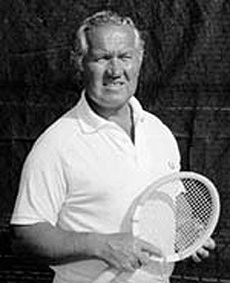
The Father of Racquetball:
"The United States Racquetball Museum has the privilege of naming Dr. Bud Muehleisen as "The Father of Racquetball.” In my opinion, this is one of the easiest decisions I have ever made, and I would like to make it official. In this section of the museum, I will take you through why Dr. Bud is the "Father of Racquetball.” He is truly a living legend.
First National Championship:
That same year, Sobek’s National Paddle Rackets Association held the first national championship tournament in Milwaukee in 1968. It was call the Gut-Strung Paddle Rackets National Championship.
Kendler utilized the USHA and its publication, ACE, to promote the new sport, while Sobek continued in his clinics and other efforts at bringing athletes to the game. In 1969, the IRA took over the National Championship, holding their first tournament in St. Louis.
In the late 1970’s, racquetball history saw a huge surge in the popularity of the game. Sales of racquetball equipment skyrocketed, and players demanded new racquetball clubs and courts across the country. Meanwhile, sporting goods manufacturers developed new equipment that was specifically designed for racquetball. By 1974, there were about 3 million racquetball players in the US. That year also marks the first professional tournament held by the IRA.
Paddle Racquets:
In the 1940’s Sobek was dissatisfied with the indoor court sports available, and it is said that Sobek sought a way to make handball less hard on his hands. He and a partner began playing the sport with paddles, and in 1949, Sobek “invented” a game called “paddle racquets.” This game combined the rules of squash and handball.
First Racquetball World Championship:
In the 1980’s, racquetball became one of the fastest growing sports in the US. The Women's Professional Racquetball Association was founded in 1980. The United States hosted the first Racquetball World Championship in 1981, and just a year later, the US Olympic Committee recognized racquetball as a developing Olympic sport.
Popularity:
In the 1980’s, racquetball was one of the fasted growing sports in the US. The Ladies Professional Racquetball Association (LPRA) was founded in 1980. Other recent landmarks in racquetball history include:
1981: The first Racquetball World Championships were held
1982: The US Olympic Committee recognized racquetball as a developing Olympic sport
1995: Racquetball achieved full medal status in the Pan-American games
By 1998, there were an estimated 10 million US players, and about 14 million players in over 90 countries around the world.
Governing Bodies
International Racquetball Federation (IRF):
The International Racquetball Federation is the governing body for all internationally sanctioned racquetball events. Developed in the early 1960s as an alternate workout for tennis players during the winter, racquetball is an extremely fast sport where balls can travel in excess of 150 mph in a 40 ft. long, 20 ft. wide, and 20 ft. high court.
History:
The International Racquetball Federation (IRF) was formed in 1979 with 13 National Racquetball Federations across four continents before quickly expanding to over 70 countries. It was recognized by the International Olympic Committee (IOC) in 1985, one of the youngest sports ever to receive this recognition.
Racquetball was one of the charter members of the World Games first held in 1981. It has been included in five IOC-Recognized Continental Games, including the Pan American Games, since 1995.
The IRF is a proud member of the International Olympic Committee (IOC), Association of Recognized Sports Federations (ARISF), World Games, Pan American Sports Organization (PASO), and SportAccord.
To Visit IRF Click Here
Awards Related To Racquetball
USA RACQUETBALL:
Joe Sobek Outstanding Contribution Award
This Award is based on an outstanding commitment to the sport of racquetball.
Presidential Award
This award is presented to the State President who has exhibited outstanding organizational performance in their State.
John Halverson Fair Play Award
This award recognizes an athlete who exercised an exceptional gesture of fair play during the year or for an athlete who has consistently demonstrated a spirit of fair play during their sports career.
Peggy Steding Female Age Group Award
An outstanding female athlete, age 35 and over, is selected on the basis of her performance for the preceding year
Bud Muehleisen Male Age Group Award
An outstanding male athlete, age 35 and over, is selected on the basis of his performance for the preceding year.
Female Athlete of the Year Award
Awarded to the most outstanding female athlete based on demonstrated performance in the previous twelve months.
Male Athlete of the Year Award
Awarded to the most outstanding male athlete based on demonstrated performance in the previous twelve months.
TXRA Annual Awards:
I) Ann Gibbons Memorial Sportsmanship - Presented to a person who has demonstrated honesty, integrity and fairness during racquetball play, tournaments and all other aspects related to the sport.
II) Male Athlete of the Year - Awarded to a male player that has demonstrated significant improvement in performance and demonstrated good sportsmanship on and off the court, in the sport of racquetball.
III) Female Athlete of the Year - Awarded to a female player that has demonstrated significant improvement in performance and demonstrated good sportsmanship on and off the court in the sport of racquetball.
IV) Junior male Athlete of the Year - Awarded to the male player that is 18 years and under that has demonstrated significant improvement in his performance. Demonstrated good sportsmanship on and off the court in the sport of racquetball.
V) Junior Female Athlete of the Year - Awarded to the female player that is 18 years and under that has demonstrated significant improvement in her performance. Demonstrated good sportsmanship on and off the court in the sport of racquetball.
VI) Outstanding Racquetball Contributor - Presented to a male or female that has demonstrated commitment to the sport and has volunteered time above and beyond to enhance the sport of racquetball in Texas.
NCRA Awards:
- NCRA Athlete of the Year
- Sportsmanship Award
- Jan R. Stelma Contributor Award
- Junior of the Year Award
CVRA Annual Awards:
Player of the Year (Male and Female) - This award is given to those who have shown outstanding performance within their respective divisions and have also shown good sportsmanship both on and off the court. This award can also include those players who have shown dramatic improvement in their play.
Curt Rettke Sportsmanship Award (Male and Female) - This award is given to those who have shown outstanding sportsmanship throughout the year. These players could be any age. The board will take into consideration not only consistent sportsmanship, but also any situation that went above and beyond the standard.
Junior Player of the Year (Boy and Girl) - This award is given to those juniors who have demonstrated the most outstanding attitude, sportsmanship both on and off the court, and performance within their divisions over the past year.
Most Improved Junior (Boy and Girl) - This award is given to those juniors who have shown the most dramatic improvement in their skill level over the past season. These juniors must also demonstrate enthusiam for the game and good sportsmanship.
Sample Documents Of Racquetball
-Pele

